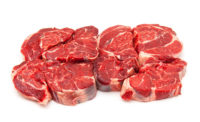 The year 2009 is behind us, probably to the great relief of many in the industry. Economic struggles, food safety concerns and supply-and- demand imbalances caused many companies to restructure their operations or lower their expectations. Of course, 2010 will be bringing its share of potential challenges and issues as well, but the hope is that the country and economy is primed for a turnaround.
The year 2009 is behind us, probably to the great relief of many in the industry. Economic struggles, food safety concerns and supply-and- demand imbalances caused many companies to restructure their operations or lower their expectations. Of course, 2010 will be bringing its share of potential challenges and issues as well, but the hope is that the country and economy is primed for a turnaround.“Fiscal 2010 should be a much better year,” said Jim Lochner, Tyson’s new chief operating officer. “We think Beef, Pork and Prepared Foods [business units] will continue with a solid performance, and we expect the steps we’ve taken to improve Chicken will manifest themselves.
“Also, USDA data points to lower overall protein supplies, and there is potential for good demand improvement as the global economy recovers,” he added.
Practically no industry had as rough a year as the pork industry did. Thanks to the mis-named “swine flu,” demand for pork products dried up domestically, and several countries temporarily closed their borders to U.S. pork imports. Several state and national politicians called for a bailout of the pork industry in 2009, noting that reduced demand and increased grain prices were causing hog producers to lose money on every animal.
Smithfield, the country’s largest pork processor, cut its pork herd and stated that the entire industry needed to reduce the size of the pork herd by 10 percent to raise prices above production costs.
Smithfield changed its company focus in 2009, and C. Larry Pope, president and CEO, said that it will benefit the company in the coming years.
“Our packaged meats business continued to deliver record profits in the second quarter. This is the part of the business we have focused on and it is repeatedly delivering superior results,” he said.
While H1N1 fears have mostly dissipated and exports are resuming, problems with excessive levels of the antibiotic oxytetracycline in pork products are currently causing problems with Russian imports. Smithfield, along with other companies, has seen several of its plants get placed on the ban list. Pope said in a conference call that he believes the Russian market is closing to U.S. pork. However, he added, Mexico has been a strong market, and the imminent opening of China’s borders will also help matters.
Domestically, consumers increasingly turned from restaurants to eating at home and traded down in proteins from steak to chicken. Poultry processor Sanderson Farms benefited with record sales in its fiscal year, totaling $1,789 billion. Chairman and CEO Joe Sanderson is hoping for a successful 2010 on the poultry side, especially if the economy does continue its signs of improvement.
“While retail grocery trends remain favorable, meaningful improvement in demand for chicken from foodservice customers will not likely occur until the national employment situation improves and consumers start dining out again,” he said. “However, we believe the industry, through earlier production cuts now being reflected in reduced egg sets and pullet placements, is well positioned to benefit from and respond to any market improvement.”
Energy costs in 2010
In 2009, many companies looked inward to improve profitability, making changes to reduce their energy costs where possible. U.S. Energy Services, an energy procurement group, estimates that energy costs will be relatively stable this year, but the potential for radical increases is coming.
Brad Smith, price risk manager, says that an expected steep decline in natural gas supply in 2009 ended up being a more moderate change. The number of conventional rigs in the country has dropped sharply, but more unconventional gas rigs horizontal drilling or new shale formations are coming online.
“Supply really hasn’t declined, because the productivity of the unconventional rigs that are coming on has been so much more dramatic than the productivity of the conventional rigs that have gone offline,” Smith says. He adds that the price for gas will only increase if there is a supply decline.
“The only time it’s on the board is at the very end of 2010,” Smith notes.
Energy prices are also dependent on Washington, and Casey Whelan, vice president strategic initiatives for U.S. Energy, points to three pieces of legislation that could impact future energy costs.
The cap-and-trade legislation has garnered the most of the attention. It would limit the amount of carbon that can be emitted into the atmosphere each year by putting a price on carbon emissions.
“The price of carbon [would] go up to the point that it economically convinces people not to do it,” he explains. Secondly, the House version of cap-and-trade includes a renewable portfolio standard, which would require electric utilities to have an increasing amount of their generation portfolio come from renewable generation, such as solar or wind power. There is also a low-carbon fuel standard that would require the fuel mix in America increasingly be comprised of renewable fuels, such as ethanol.
Naturally, any increase in the amount of corn-based ethanol put into the gasoline mix would raise feed prices, which would in turn reduce profitability throughout the meat industry and its supply chain. Ironically, ethanol use may be in conflict with the cap-and-trade legislature, as California has determined that ethanol has a higher carbon footprint than gasoline.
Whelan said the hope was to pass this legislation last year, and that failure makes it unlikely to be passed this year.
“Politics being what they are, it’s going to be tough to pass any climate change legislation in 2010, because it’s an election year,” he says. However, passage of that legislation, if and when it happens, will likely send energy prices soaring. Whelan estimates that $14-per-ton carbon will increase gasoline by 6 percent, electricity by 11 percent and natural gas by 12%.
“Now, the thought is that $14 is really on the low end of where we’ll be, and if you really want to incent people to change behavior, you probably need something closer to a $40-per-ton number,” Whelan says. In that instance, gasoline increases by 22 percent, electricity by 38 percent and natural gas by 44 percent. Prices also may vary regionally, depending on the carbon profile in a particular part of the country.
“You could see electric prices in the Midwest double and maybe go up only 10 percent in California,” he says.



Report Abusive Comment